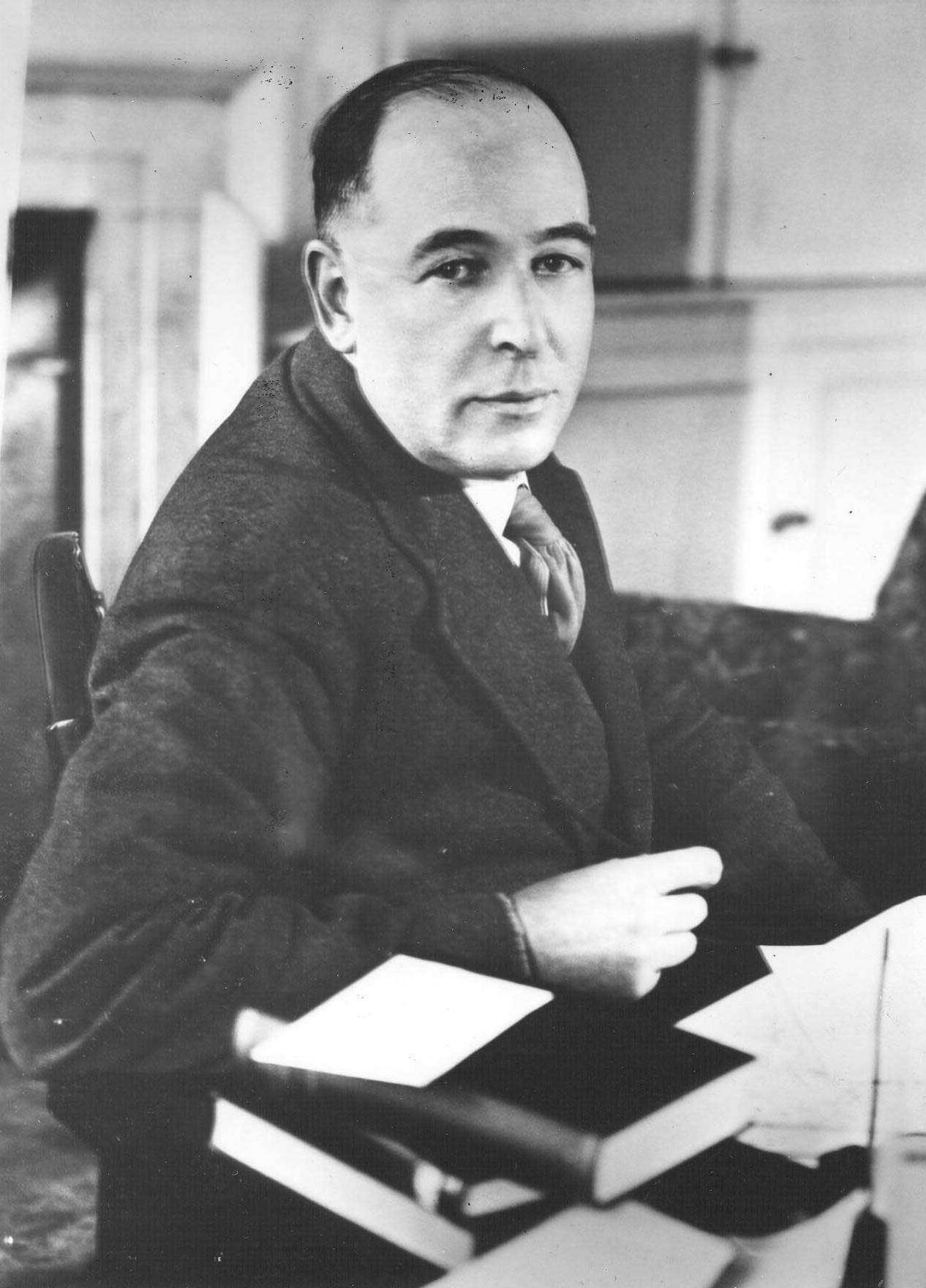
On June 8, 1941, C.S. Lewis stepped outside of The Kilns, the residence on the outskirts of Headington Quarry he shared with his older brother, Warnie, and their demanding 69-year-old housemate Mrs. Janie Moore, the mother of a friend who had died in World War I.
It was a pleasant Sunday evening, with a slight breeze in the air and a temperature of 11 °C (61°F).

Lewis, who never learned to drive, eased his way into the car to be driven by Fred Paxford, the gardener and handyman who had worked at The Kilns since before Mrs. Moore and Lewis acquired the property in 1930. Paxford and Lewis were both 42-year-old bachelors—the latter just three months older than the former. Years later, when Lewis wrote The Silver Chair in his Narnia series, he based the character Puddleglum the Marsh-Wiggle on Paxford: “an inwardly optimistic, outwardly pessimistic, dear, frustrating, shrewd countryman of immense integrity.”
With Paxford behind the wheel, the two men made their way west along London Road, which soon turned into Headington Road. The three-mile trip takes around 15 minutes by car. They arrived at their destination, the University Church of St Mary the Virgin, located on the north side of High Street, where Lewis was to deliver the Solemn Evensong sermon.

Originally built in the 13th century as the home of the university, St Mary’s—the parish church of Oxford University—hosted notable figures and events in virtually ever century.
In the 16th century archbishop Thomas Cramner, along with bishops Latimer and Ridley, were tried for heresy in the church and executed at Broad Street.
In the 18th century John Wesley attended sermons in the church as an undergraduate student and later preached from its pulpit.
In the 19th century John Henry Newman served as vicar of the church, delivering well-received sermons until he left the Church of England in 1845 and was received into the Roman Catholic Church.
The 1940s saw Lewis increasing in popularity and visibility. In February he had received a letter from Rev. J. W. Welch, director of the Religious Broadcasting Department of the BBC, inviting Lewis to give a series of wartime radio addresses, which he would begin delivering in August. In May, The Guardian had begun publishing weekly installments of Lewis’s “Screwtape Letters.” Six years later, in September of 1947, he would grace the cover of Time magazine.
Lewis preached several sermons throughout his lifetime. Almost all of the surviving records are from the 1940s, where he preached nearly 20 sermons, many of them as a volunteer Lay Lecturer for the RAF (Royal Air Force) Chaplains’ Branch.
Fifteen months before he preached “The Weight of Glory” he had given an evensong sermon at St Mary’s entitlted “None Other Gods: Culture in War-Time” (October 22, 1939), later shortened and recast in publication form as simply “Learning in War-Time.” Both sermons were at the invitation of Canon T. Richard (“Dick”) Milford, the 45-year-old Vicar of St Mary’s, and both were prompted by his reading of The Pilgrim’s Regress (1933), Lewis’s first Christian book.
England, of course, was heavily engaged in World War II at this time. Between these two preaching engagements at St Mary’s—from September 7, 1940, to May 21, 1941—British cities were on the receiving end of 100 tons of explosives dropped during air raids, including 71 attacks upon London, some 60 miles to the southeast.
As Lewis ascended the pulpit that evening, he looked out at the Oxford students and dons to witness what Walter Hooper later described as “one of the largest congregations ever assembled there in modern times.”
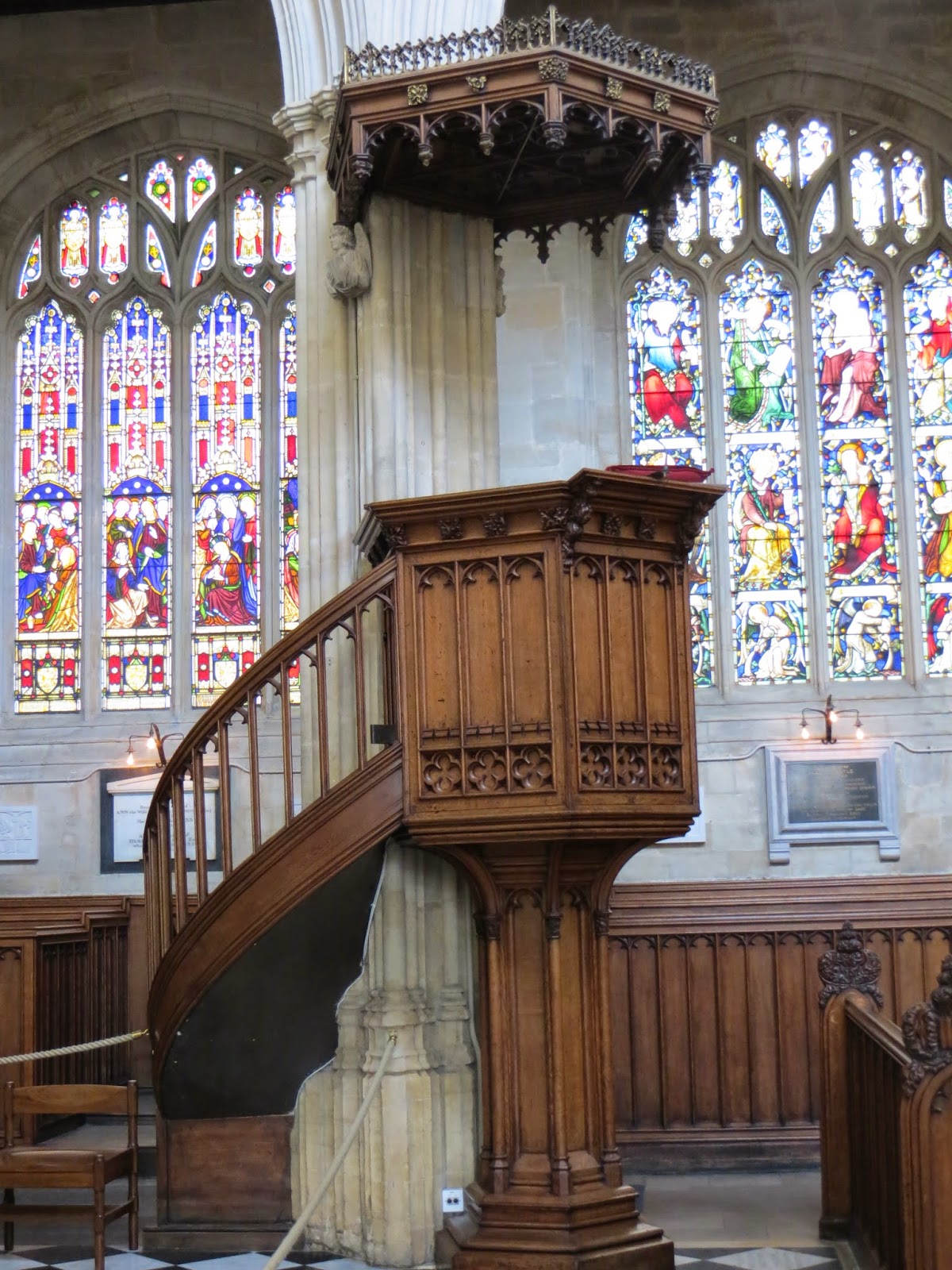
The anticipation to hear Lewis must have been significant, but the listeners could hardly have predicted that they were about to hear what would become one of the most famous sermons of the twentieth century, still being read and appreciated seventy five years hence.
Lewis’s announced text for the address was Revelation 2:26, 28, a passage different from the day’s New Testament reading in the Book of Common Prayer: “And he that overcometh, and keepeth my works unto the end, to him will I give power over the nations . . . And I will give him the morning star” (KJV). Lewis does not quote from the passage directly or refer to it by its reference, though he does discuss near the end of the sermon what it means to be given “the morning star.”
The title of the sermon, “The Weight of Glory,” comes from 2 Corinthians 4:17: “For our light affliction, which is but for a moment, worketh for us a far more exceeding and eternal weight of glory.” But even this verse receives only a passing mention in the course of his remarks. One of the striking features about Lewis’s sermonic work is how little exegetical work they contain. They are more like philosophical, theological, and practical meditations on themes than exposition proper.
The address in printed form is just over 5,300 words. Based upon his speaking pace from his surviving audio, where he spoke at a clip of 120 words per minute, this talk at the same rate would have lasted about 45 minutes.
Lewis’s two-and-a-half minute opener is now one of his best-known passages:
If you asked twenty good men to-day what they thought the highest of the virtues, nineteen of them would reply, Unselfishness. But if you asked almost any of the great Christians of old he would have replied, Love.
You see what has happened? A negative term has been substituted for a positive, and this is of more than philological importance. The negative ideal of Unselfishness carries with it the suggestion not primarily of securing good things for others, but of going without them ourselves, as if our abstinence and not their happiness was the important point.
I do not think this is the Christian virtue of Love. The New Testament has lots to say about self-denial, but not about self-denial as an end in itself. We are told to deny ourselves and to take up our crosses in order that we may follow Christ; and nearly every description of what we shall ultimately find if we do so contains an appeal to desire.
If there lurks in most modern minds the notion that to desire our own good and earnestly to hope for the enjoyment of it is a bad thing, I submit that this notion has crept in from Kant and the Stoics and is no part of the Christian faith.
Indeed, if we consider the unblushing promises of reward and the staggering nature of the rewards promised in the Gospels, it would seem that Our Lord finds our desires, not too strong, but too weak. We are half-hearted creatures, fooling about with drink and sex and ambition when infinite joy is offered us, like an ignorant child who wants to go on making mud pies in a slum because he cannot imagine what is meant by the offer of a holiday at the sea. We are far too easily pleased.
On August 17, a couple of months after delivering the sermon, Lewis responded to Alec Vidler, the Anglo-Catholic editor of the monthly journal Theology, granting him permission to publish the talk. It appeared that fall: C. S. Lewis, “The Weight of Glory,” Theology 43, no. 257 (November 1941): 263-74.
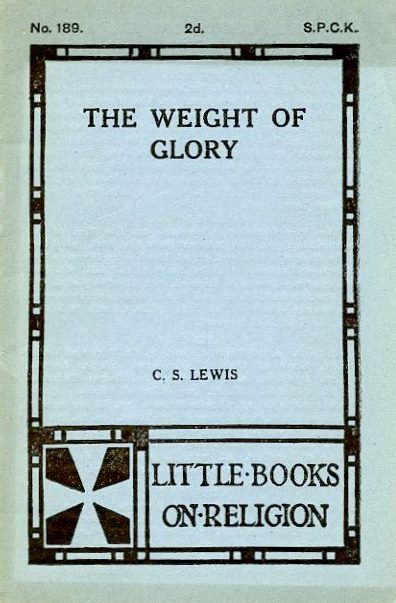
The following year, the Anglican mission organization Society for Promoting Christian Knowledge (SPCK), which publishes Theology, produced the address as a 4.25″ x 6.5″ 24-page pamphlet, sold for 2 pence. (An original is reprinted to the right.)
At the end of the decade, the British publisher Geoffrey Bles released Lewis’s Transposition and Other Addresses (1949) as a 62-page hardcover, containing five essays:
- “Transposition”
- “The Weight of Glory”
- “Membership”
- “Learning in War-Time”
- “The Inner Ring”
The American edition, published the same year by Macmillan, dropped the “Transposition” essay and changed the book title to highlight The Weight of Glory and Other Addresses.
Lewis explained in the preface that all of the addresses were for specific requests and addressed to particular audiences, and that they are largely reprinted as originally given.
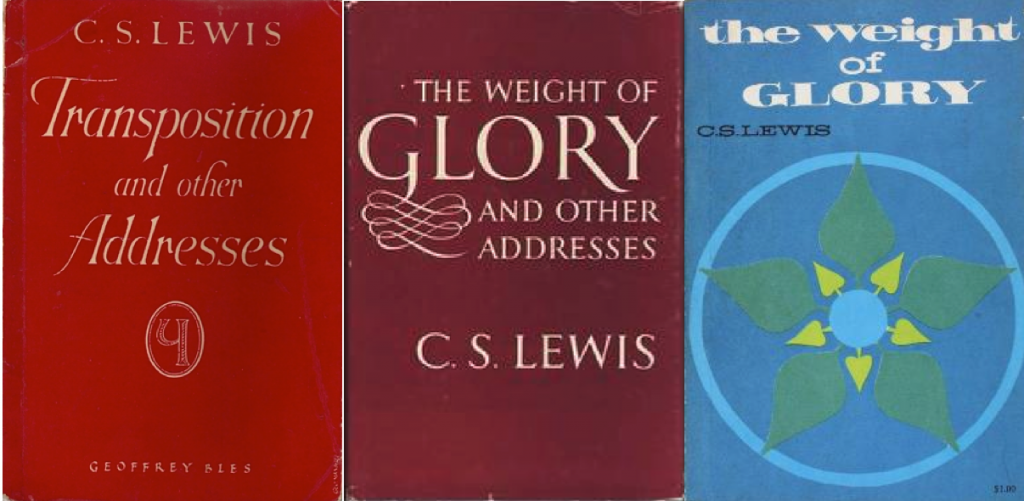
In 1980, Macmillan released a revised and expanded edition, with a new introduction by Walter Hooper, literary adviser to the Lewis estate and Lewis’s secretary at the end of his life. To the original five essays, Hooper restored “Transposition” and included four more: “Why I Am Not a Pacifist,” “Is Theology Poetry?” “On Forgiveness,” and “A Slip of the Tongue.”
Hooper arranged the various essays chronologically, with one exception: he placed “The Weight of Glory” at the front, writing that it is “so magnificent that not only do I dare to consider it worthy of a place with some of the Church Fathers, but I fear I should be hanged by Lewis’s admirers if it were not given primacy of place.”
Hooper’s comments note the longstanding popularity of “The Weight of Glory” among Lewis’s admirers, but the essay became especially well-known among Reformed evangelicals through the writings of John Piper. Piper discovered Eerdmans’ 1965 paperback edition of The Weight of Glory in the fall of 1968, as a first-year student at Fuller Seminary, while browsing at Vroman’s Bookstore on Colorado Avenue in Pasadena, just a few blocks southeast of the seminary.
“The first page of that sermon,” he now says of the passage quoted above, “is one of the most influential pages of literature I have ever read.” “There it was in black and white,” Piper recounts, “and to my mind it was totally compelling: It is not a bad thing to desire our own good. In fact, the great problem of human beings is that they are far too easily pleased. They don’t seek pleasure with nearly the resolve and passion that they should. And so they settle for mud pies of appetite instead of infinite delight.” He had never in his whole life heard a Christian, let alone one of Lewis’s stature, say these kinds of things, and Piper became convinced that our fault lay not in our desire for happiness but in the weakness of our quest for true and lasting joy.
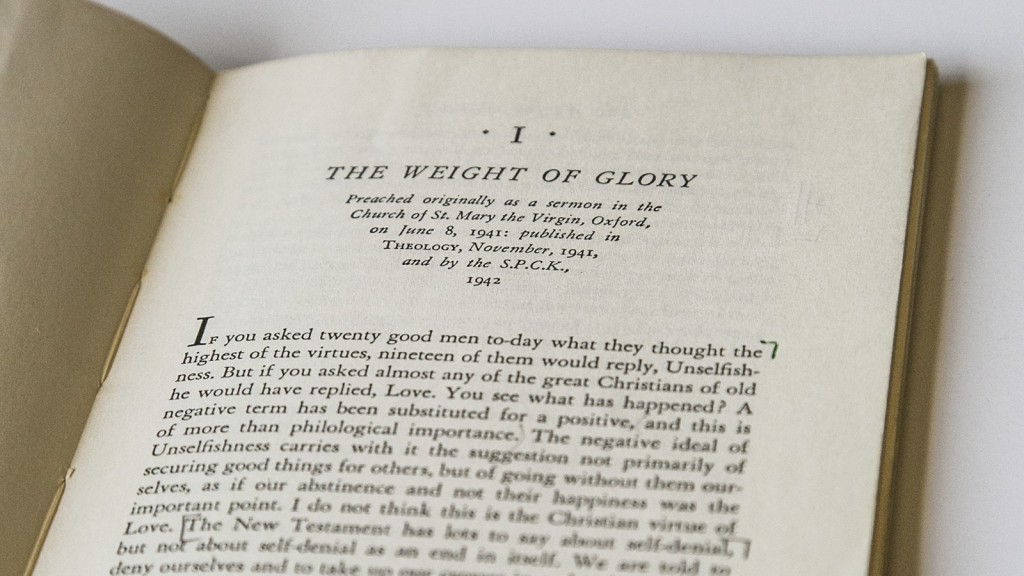
Nearly a decade later, while teaching biblical studies at Bethel College, Piper published “How I Became a Christian Hedonist,” His 37 (March 1977): 1, 4-5, building off of Lewis’s insights from “The Weight of Glory,” combined with that of the Psalms, Lewis’s Reflection on the Psalms, and the writings of Blaise Pascal. In 1986, Piper expanded this essay, this time incorporating the work of Jonathan Edwards, which became the introduction to his signature book, Desiring God: Meditations of a Christian Hedonist.
“The Weight of Glory” can be read online in its entirety. (You can also read my summary of each section here.) As the length of this post might suggest, it is worth the investment of your time to read and consider the whole thing. For it was 75 years ago tonight that the church received one of the great sermons of the 20th century.



















